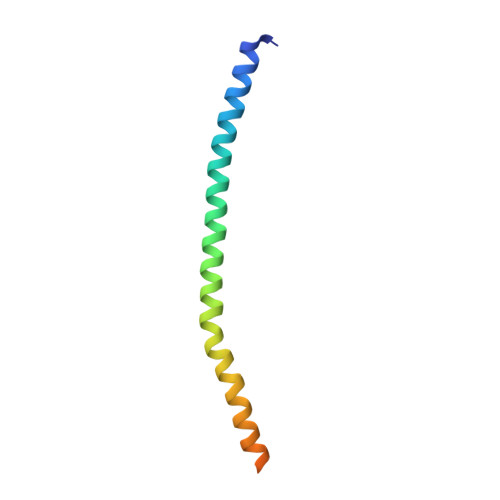Tola Modulates the Oligomeric Status of Ybgf in the Bacterial Periplasm.
Krachler, A.M., Sharma, A., Cauldwell, A., Papadakos, G., Kleanthous, C.(2010) J Mol Biology 403: 270
- PubMed: 20816983
- DOI: https://doi.org/10.1016/j.jmb.2010.08.050
- Primary Citation of Related Structures:
2WZ7, 2XDJ, 2XEV - PubMed Abstract:
The trans-envelope Tol complex of Gram-negative bacteria is recruited to the septation apparatus during cell division where it is involved in stabilizing the outer membrane. The last gene in the tol operon, ybgF, is highly conserved, yet does not seem to be required for Tol function. We have addressed this anomaly by characterizing YbgF from Escherichia coli and its interaction with TolA, which, based on previous yeast two-hybrid data, is the only known physical link between YbgF and the Tol system. We show that the stable YbgF trimer undergoes a marked change in oligomeric state on binding TolA, forming a one-to-one complex with the Tol protein. Through a combination of pull-down assays, deletion analysis, and isothermal titration calorimetry, we map the TolA-YbgF interface to the C-terminal tetratricopeptide repeat domain of YbgF and 31 residues at the C-terminal end of TolA domain II (TolA(280-313)). We show that TolB, which binds TolA domain III close to the YbgF binding site, has no impact on the YbgF-TolA association. We also report the crystal structures of the two component domains of YbgF, the N-terminal coiled coil from E. coli YbgF, which forms a stable trimer and controls the oligomeric status of YbgF, and the monomeric tetratricopeptide repeat domain from Xanthomonas campestris YbgF, which is also able to trimerize. Although the coiled coil is not directly involved in TolA binding, we demonstrate that the regular hydrophilic patterning of its otherwise hydrophobic core is a prerequisite for the TolA-induced oligomeric-state transition of YbgF. We postulate that rather than YbgF affecting Tol function, it is the change in YbgF oligomeric status (with an accompanying change in its function) that likely explains the necessity for tight co-regulation of the ybgF and tol genes in Gram-negative bacteria.
- Department of Biology, University of York, Heslington, PO Box 373, York YO10 5YW, UK.
Organizational Affiliation:


















